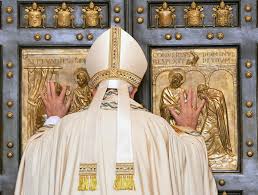Stamp: Pope Francis opening Door of St. Peter's Basilica (Vatican City 2025)
Pope Francis opening Door of St. Peter's Basilica (Vatican City 2025)
27 February (Vatican City ) within release Holy Year 2025 goes into circulation Stamp Pope Francis opening Door of St. Peter's Basilica face value 1.25 Euro
| Stamp Pope Francis opening Door of St. Peter's Basilica in catalogues | |
|---|---|
| Colnect codes: | Col: VA 2025.02.27-01 |
Stamp is horizontal format.
Also in the issue Holy Year 2025:
- Stamp - Doos of St. Mary Major and St. Paul Outside the Walls face value 3.20;
- Stamp - Doos of St. Peter's Basilica and St. John Lateran face value 2.45;
- Stamp - Pope Francis opening Door of Rebibbia Prison face value 1.30;
- Stamp - Pope Francis opening Door of St. Peter's Basilica face value 1.25;
Stamp Pope Francis opening Door of St. Peter's Basilica it reflects the thematic directions:
A church building, often simply called a church, is a building used for Christian religious activities, particularly worship services. The term in its architectural sense is most often used by Christians to refer to their religious buildings, but it is sometimes used (by analogy) for buildings of other religions. In traditional Christian architecture, the church is often arranged in the shape of a Christian cross. When viewed from plan view the longest part of a cross is represented by the aisle and the junction of the cross is located at the altar area. Towers or domes are often added with the intention of directing the eye of the viewer towards the heavens and inspiring church visitors. Modern church buildings have a variety of architectural styles and layouts; many buildings that were designed for other purposes have now been converted for church use; and, similarly, many original church buildings have been put to other uses. The earliest identified Christian church was a house church founded between 233 and 256. During the 11th through 14th centuries, a wave of building of cathedrals and smaller parish churches occurred across Western Europe. A cathedral is a church, usually Roman Catholic, Anglican, Oriental Orthodox or Eastern Orthodox, housing the seat of a bishop.
in Western Christianity, the tradition dates to 1300, when Pope Boniface VIII convoked a holy year, following which ordinary jubilees have generally been celebrated every 25 or 50 years, with extraordinary jubilees in addition depending on need. Catholic jubilees, particularly in the Latin Church, generally involve a pilgrimage to a sacred site, normally the city of Rome. The Catholic Church declared the Extraordinary Jubilee of Mercy for 2015–2016.
The pope (Latin: papa, from Ancient Greek: πάππας, romanized: páppas, lit. 'father') is the bishop of Rome and the visible head[a] of the worldwide Catholic Church. He is also known as the supreme pontiff, Roman pontiff, or sovereign pontiff. From the eighth century until 1870, the pope was the sovereign or head of state of the Papal States, and since 1929 of the much smaller Vatican City state.From a Catholic viewpoint, the primacy of the bishop of Rome is largely derived from his role as the apostolic successor to Saint Peter, to whom primacy was conferred by Jesus, who gave Peter the Keys of Heaven and the powers of "binding and loosing", naming him as the "rock" upon which the Church would be built. The reigning pope is Francis, who was elected on 13 March 2013.


